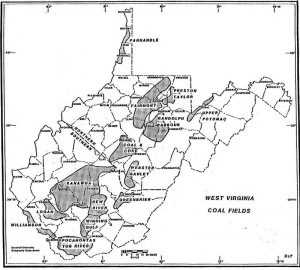
The Greenbrier Coal Field is the name used to describe a coal-producing section of West Virginia that includes the following counties, in whole or in part: Greenbrier County.
Coal Seams of the Greenbrier Coal Field
Most of the coal from the Greenbrier Coal Fields has come from the Sewell seam of Meadow Creek, within a few miles of Sewell Mountain. The seam was rarely less than five feet thick and twelve feet of clean, pure coal was found in some localities along Clear Creek.
Development of the Greenbrier Coal Field
The Greenbrier Coal Field was one of the later coal fields developed in West Virginia. For several decades development of the Greenbrier field was hampered due to lack of a transportation link to carry the coal to market. The Elkins and Davis interests had purchases rights to the large acreage in the 1870s, and Henry G. Davis had planned the construction of a railroad line into the field from a connection with Chesapeake & Ohio Railway (C&O) at a point in Randolph County to develop the field but did not follow through with those plans.
The first commercial mine opened in Greenbrier County was the Elk Lick Coal Company, which opened in about 1906. By 1910 the company had mine at Spruce Knob, and another at Lost Flat in operation, and by 1917 the Elk Lick Company had opened its Spruce Knob mines, while the Meadow River Smokeless Coal Company was in operation in East Rainelle, WV.
A line of the Sewell Valley Railroad was completed in 1916, running between the C&O mainline at Meadow Creek, WV to Rainelle, WV in 1916, resulting in the opening of several lumber mills and additional coal mines in the area.
A branch line of the Chesapeake & Ohio Railway (C&O) in the 1920s further facilitated the opening of additional mines. By 1932, ten coal companies were in operation in Greenbrier County, all but two mining from the Sewell seam; the others mining the Fire Creek seam. Another railroad branch line along Clear Creek from the mainline, at Rupert, West Virginia, permitted the opening of even more mines at Clearco and Anjean.




